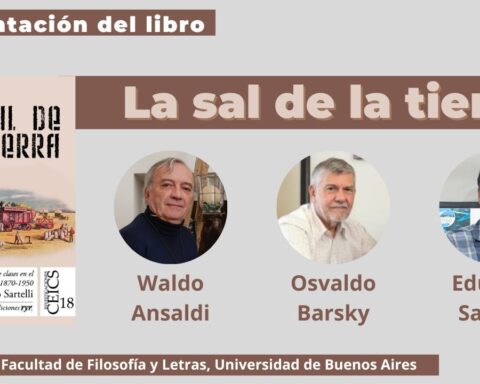LAP (Political Analysis Lab) – CEICS (Center for Study and Research in Social Sciences)
One of the arguments usually put forth by the enemies of the working class is that the left does not win elections and has a minimal presence in the workers’ movement. In the best of cases, when there are no doubts that revolutionary parties are one of the principal engines of the mobilization, as in the case of the Casino struggle in 2008, they are blamed for the defeat. However, they cannot explain the numerous cases in which the left propelled the workers’ victory in various branches of production. We have dealt with the case of the teachers in a previous opportunity. In this case, we will give an account of the recent struggle in the food industry, particularly in Arcor, which shows first-hand evidence for the depth of the crisis of the trade-union bureaucracy. It also makes clear that class struggle and workers democracy have reached the heart of Argentine capitalism.
The kernel of the system
The engine of Argentine capitalism is the agricultural sector. In fact, one of the two companies (Arcor) which accumulate on a world-scale (Arcor and Techint), does this through the competitive advantage afforded to it by the fertility of the fields. [1] Arcor, for example, counts with more than 41 plants around the world, of which 29 are located in Argentina. One of its main divisions, the one dedicated to candies, has 4 plants in Argentina: Totoral (Córdoba), Salto (Buenos Aires), Lía (Córdoba) and Villa Mercedes (San Luis). Likewise, there are two lines of production, one of cereal bars and another of alfajores (singular: alfajor, a candy confection traditional of Latin America and Spain), in Arroyito and Colonia Caroya, respectively. The company employs 20 thousand workers throughout the world, of which 14 thousands work in Argentine plants.
This year, Arcor received the Clarín Prize (Clarín Group, LSE is the largest media corporation of Argentina) for Entrepreneurship Excellence, being distinguished as the company with the “best reputation” in Argentina.[2] Officially valued at 1.637 billion dollars, and with an annual revenue of more the 2 billion dollars, its success is usually ascribed to the “entrepreneurial knack” of its millionaire president, Luis Pagani. [3] This is the same media discourse of Ricardo Fort, who assures us that the money he spends in his luxurious life is not the result of the labor of the workers of FelFort, but that of his father.
However, the management’s ideology of “work culture” (i.e. the bosses deserve their profits because of how hard they work) has no basis in reality. In the first place, it had already been proven that Arcor’s success has a concrete material foundation: the productivity of the Pampean agro. Secondly, the general struggle of food workers, particularly in Arcor, shows that the millions of Pagani and Fort have their origins in another factor: at the beginning of 2010, the workers of the lavishly prized Arcor were being paid salaries of only 2000 pesos. [4]
The struggle of food workers
On March 12 of this year, the internal committees of Kraft and Pepsico, together with delegates from Stani Cadbury, continued the struggle against the 53 lay-offs of 2009 and against the intensification of the rhythms of production. In the midst of great media repercussion, the demands also consisted of a 35% salary rise, the matching of salaries with the basic needs basket, the assembly election of members of the joint negotiating commission, re-incorporation of the fired workers, and an end to the deprivation of rights trials started by management against trade-union leaders and other activists.
The workers, along with a convoy of 200 students, marched to the Obelisco and the COPAL (Food Industry coordinating committee, one of the main chambers of the UIA -Argentine Industrial Union-). A few days later, the workers of Arcor in Colonia Caroya (in the province of Córdoba) paralyzed production in protest against a worker’s termination. The whole of the branch was radicalizing while on March 25th the assemblies of Kraft voted for a highway blockade and demanded Rodolfo Daer (the Food Trade Association’s Secretary General) to call for a general strike. Concurrently, the first strike in the history of Felfort was taking place, demanding permanent status for hired workers and a salary rise. Conscious (and frightened) of the politicization of his workers, Ricardo Fort emitted a press communiqué where he made explicit that: “we know that part of this group of protestors do not belong to the FelFort company, they are the ones who are violently demanding in the streets and the media with the incessant claim for a salary rise”.[6] The month of March left with strikes, blockades and the complete discredit of the bureaucracy.
On April 7th, workers of Kraft, Pepsico and Stani-Cadbury mobilize to the Ministry of Labor, at the roar of “35% rise now and permanent plant for hired workers”. Various mobilizations continued throughout the month. Another massive strike was carried out on April 9th in the whole trade, even though the trade-union leadership had imposed that it be only for two hours on each turn. On the 17th, food workers were joined by leaders from different branches (tires, meat processing plants, railroad, auto parts, textiles, and delegates from the SMATA –the mechanics trade union – and the UOM –the metal-workers trade union – in the North Section of the Greater Buenos Aires). Together they tried to impel independent trade-union associations independent of the bureaucracy and advancing in the coordination of the struggle. The strikes and intermittent blockades of Kraft and Pepsico workers ensued through various days. [7] On April 14th, the mobilization summoned up by the STIA, the Union of Food Industry Workers, and the Food Industry Federation (led by Luis Morán) took place. At the same time, the process of factory takeovers began to develop. Likewise, the strikes in Arcor began in the province of Córdoba starting on April 20th. They were joined by the four plants from the province (4,500 workers, men and women), and a grassroots organization was initiated in order to sustain the actions in unity.
In spite of the boycott carried out by an assembly of delegates behind the backs of the workers, and the mandatory conciliation ruled by the Ministry of Labor, the strike was maintained. The strikers had to confront, then, the hooliganism of the scabs of the Lista Verde, which tried to break it. Contrary to their intentions, the fleshy actions of the bureaucracy resulted in two more hours of strike in the night shift. The situation was approaching a critical point: on May 15th, a massive assembly in Stani-Cadbury voted for an indefinite strike until the management gave in.
Breaking the bureaucratic siege in Arroyito
In the beginning of May, Arcor’s management tried to break the struggle in the four plants in the province of Córdoba by offering a 30% rise only to the workers of Arroyito. More than 150 workers from other plants travelled to Arroyito to convince their fellow workers that this was a ploy. When they arrived, they found out that the strike was not being complied with and they tried to surround the plant to guarantee it, in spite of the heavy police presence. The bureaucracy tried to keep them isolated from the plant, taking them to the Union’s head office, trying to convince them that the the resolutions of the assembly in Arroyito had to be respected. At the roar of “¡piqueteros, carajo!”, these workers did not fall into the trap and gathered with their co-workers in Arroyito. Finally, the workers got around this impasse managing to get new factories to join the historic strike: some 450 workers of Georgalos (another candy company), in Río Segundo, joined the struggle with roadblocks and pickets for 24 hours, as well as workers of Nestlé, Orieta and CeBeSé.
The strike extended until May 19th and, by then, it was already an unprecedented struggle: in the whole history of Arcor, there had never been a combat with these characteristics.
A new victory for the class perspective
The struggle of food workers forced management to give a rise of 35.2%, which means a basic salary of 3,800 pesos. [8] And this was achieved even when, in joint negotiations, the Ministry of Labor had only stipulated a 26.5%, in agreement with the limit that Hugo Moyano (the CGT –General Confederation of Labor- Secretary General) tried to impose over the workers’ demands. The bureaucracy once again preferred to defend the interests of management and the government, instead of worrying about the workers’ interests. As assured by the leader of the CGT, he would do everything within his power to “not incur in excesses or anything that would affect the normal unfolding of the economy”.[9]
In spite of its calls for the strikes, the actions of the bureaucracy did not guarantee at all the conditions for their victory. In fact, it purposefully operated so as to hold back the process. For example, it did not organize funds for the struggle which would allow for the sustainment of the strike. Neither did it organize the unity of the 4 Arcor factories in Córdoba, allowing that Romero, the STIA Arroyito affiliation Secretary General, would sign the agreement with management and break the struggle. A situation which would have accorded with the desires of the Secretary of Labor, Carlos Tomada, who sought to shut up the conflict by explicit orders from Cristina Kirchner, who did not want any social confrontation to tarnish the celebrations for the Bi-Centennial. [10]
However, the workers defeated the maneuver and stayed united, in spite of the distance and the manipulations of the bureaucracy and management, under the banner of “an injury to one is an injury to all”. They were able to get the bureaucracy off their shoulders with the organization and advance of the sectors which fought with a class struggle perspective. In this sense, the workers of Arcor (Villa Mercedes), maintained that “there needs to be organization in order to kick out the disloyal union leaders who sign agreements behind the backs of the workers”. Likewise, in Lia-Bagley, internal committees were elected and a leadership was constituted which, from this factory, was able to advance fundamental decisions on the conflict adhered to by the whole trade association, and not abiding by the mandatory concession when it had been ordained it thus achieved two national strikes which united 60 thousand food workers. This was how the 3,800 pesos basic salary was achieved. The workers were also able to veer the trade association in their direction. The Internal Committee was actually able to mortgage the lot of the Federation to carry the conflict forward: “what good are the assets of the trade association, if it’s not to support the struggle.”[11]
True to form, the bourgeoisie tried to legitimate the lay-offs and the repression declaring that workers and parties are very different things. Marta Fort, who owns Felfort, insisted that “the people who are pulling off these roadblocks are not part of the company. It’s people of the left. The workers of my company are lovely and want to work.”
You reap what you sow
As we have been pointing out, the radicalization of the Argentine working class is hardly a narrow phenomenon. The disenchantment of workers with the bureaucracy has opened the road for the advance of the sectors committed to class struggle, which did not come from nowhere, but thanks to the patient and everyday intervention of revolutionary parties. It is no coincidence that the 35% rise has been achieved in the food industry: the work of the revolutionary left has concentrated on it for a long time.
The PO, as much as the PTS, and even the PCR and MST, are now collecting the fruits of years of work. In Felfort, Kraft-Terrabusi, Pepsico, Stani Cadbury, Lia-Bagley and Arcor, the workers are showing that they do not follow the dictates of the bureaucracy anymore, but that, increasingly, they are conscious of the necessity of having to confront management and the capitalist system to defend their interests.
If the example of Kraft signified a qualitative step forward in the class struggle, we are now facing the expansion of this struggle in the whole branch. This new conflict incorporated the workers of the most important company in the country to the struggle, which expresses a new advance in the organization and the revolutionary consciousness of all workers. The victory of the 35% rise and the breach of the salary ceiling will now be part of the demands of thousands of activists who will join the struggle for a new life. In the midst of the fiery embarrassment of the trade-union bureaucracy, the deterioration of the material conditions of labor for all workers, and the deepening of combats, a new generation of leftist workers is ripening with the heat of the crisis. The revolutionary left is preparing for a new harvest.
(1) See Baudino, Verónica: El Ingrediente Secreto, Ediciones ryr, Bs. As., 2009.
(2) www.ieco.clarin.com, 9/5/2010.
(3) www.lavoz.com.ar, 1/4/2010.
(4) http://www.cadena3.com.ar/contenido/2010/04/23/51545.asp.
(5) http://www.pts.org.ar/spip.php?article15248. The actions of the workers were taken from the party presses of the PO, the PTS, the MST and the PCR.
(6) http://www.diarioshow.com/notas/2010/03/25/29822-ricardo-fort-le-responde-a-sus-empleados.html
(7) http://trabajadoresdeterrabusi.blogspot.com/2010/05/trabajadores-de-la-alimentacion-marcan.html
(8) http://www.lanacion.com.ar/nota.asp?nota_id=1266345
(9) http://www.lanacion.com.ar/nota.asp?nota_id=1271016
(10) http://www.tn.com.ar/2010/05/20/politica/02197826.html.
(11) http://trabajadoresdeterrabusi.blogspot.com/2010/05/trabajadores-de-la-alimentacion-marcan.html







